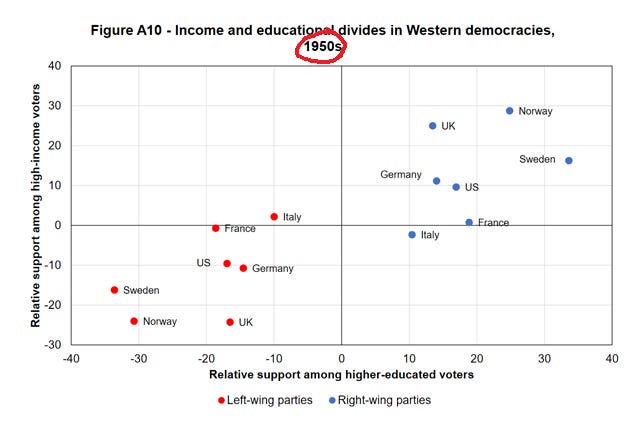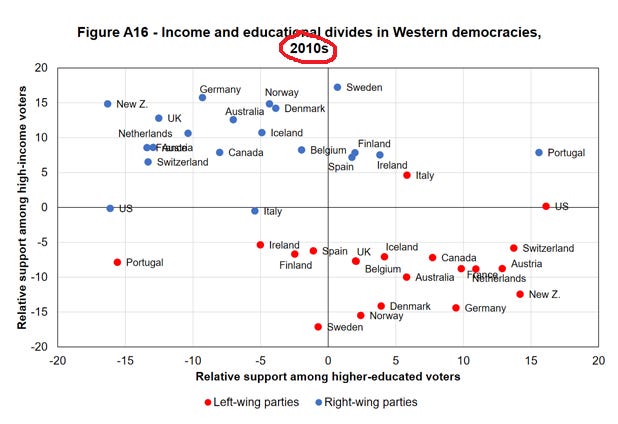Contra Hanania On Partisanship
Richard Hanania of the Center For The Study Of Partisanship And Ideology asks “why is everything liberal?” Given that there are approximately equal numbers of Trump voters and Biden voters in elections, how come we have “woke capital” celebrating Pride Month, instead of unwoke capital celebrating some conservative cause (as might have happened fifty years ago)? How come conservatives worry about censorship by liberal tech companies instead of vice versa? How come conservatives worry about college turning their kids liberal instead of vice versa?
 Source:Hanania’s post
Source:Hanania’s post
He concludes that “liberals win because they care about politics more”. This may come as a surprise to anyone familiar with Fox News, YouTube, Twitter, or the federal government, but he has lots of data in support (and note that Hanania himself is conservative, so this isn’t a cheap attack). Liberals donate more, even though both sides control about equal pools of money. Liberal protests attract orders of magnitude more protests than conservative ones. Liberals express more willingness to shun people for being conservative than vice versa. And liberals are more willing to take low-paying (but important-for-gaining-power) activist jobs. He writes:
There’s a great irony here. Conservatives tend to be more skeptical of pure democracy, and believe in individuals coming together and forming civil society organizations away from government. Yet conservatives are extremely bad at gaining or maintaining control of institutions relative to liberals. It’s not because they are poorer or the party of the working class – again, I can’t stress enough how little economics predicts people’s political preferences – but because they are the party of those who simply care less about the future of their country.
I don’t want to argue with his data showing that conservatives care less. But even if it’s true, I don’t think it’s the root issue. The reason everything is liberal is because of the stuff Thomas Piketty keeps trying to tell us about our shifting coalition system.
II.
You can find this in Piketty’s new book Capital And Ideology, or if you don’t have the attention span to get through a 1104 page book, his more recent paper Brahmin Left Vs. Merchant Right: Changing Political Cleavages In 21 Western Democracies 1948-2020. Or, if even a 32 page paper is pushing it, here are three graphs:
In the 1950s, most western democracies had an elite party (right-wing) vs. an anti-elite party (left-wing), and the elite party captured both the richest and the best-educated segments of the population. Over time, this shifted to democracies having a multi-elite system: a financial-elite party vs. an educational-elite party (realistically, educated people are more likely to be rich and vice versa, so this is more of a relative thing - are you more rich than education, or vice versa?) The United States is a bit of an outlier, and its party cleavage seems to be entirely around education, with wealth having little predictive power.
Here are some other graphs about the American situation in particular, from an earlier Piketty paper:
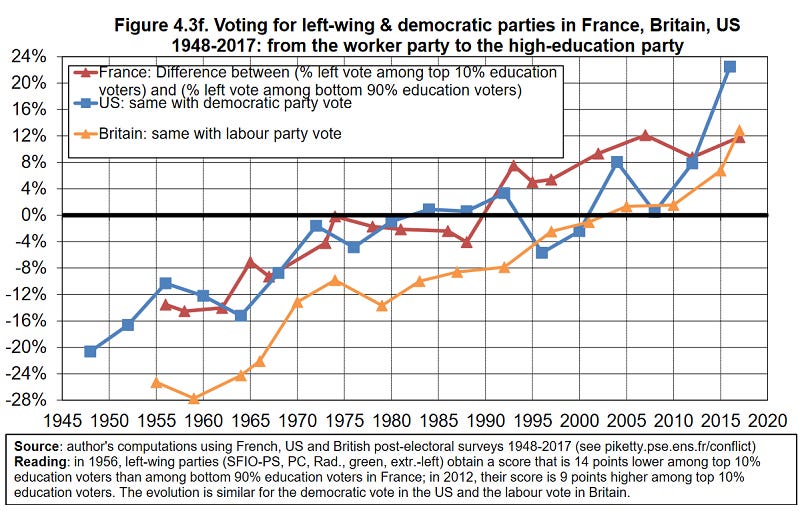 Remember when I said there would only be three graphs? I lied.
Remember when I said there would only be three graphs? I lied.
In 2016, for the first time, the richest 1% were more likely to support Democrats than Republicans. This may have reversed in 2020 - I can’t find the vote broken down by income percentile, but there was a general trend for rich people to be somewhat more likely to support Trump than in 2016. If this is real and continued, it might bring the US closer to the European mainstream.
Why has elite/common polarization switched to wealth/education polarization? Piketty and his commenters raise a couple of possibilities. First, more people have college degrees - in 1948, it was only 6% of Americans; today it’s 32%. Although there’s always a most-educated half of the population, college forms a bright line dividing people into two groups, and a group of 32% of people makes a better coalition nucleus than a group of 6% of people. Also, everyone could aspire to become a high school graduate, whereas not many people expect everyone to go to college, and nobody (?) wants everyone to get a PhD. That means the college-educated feel more like a special elite.
But also, countries are getting more diverse. In 1950, the US was 90% white; today it’s more like 70%. Racial conflicts make it hard to keep poor whites and poor minorities together in a “grand coalition of the poor”. That naturally lends itself to a multi-elite system, where one faction of elites wins the allegiance of poor minorities and the other of poor whites. Piketty thinks the same process might be happening in other countries with eg Muslim immigrants, and says he’s working on analyzing data from ethnically homogenous countries to see if they’re having less educational polarization shift than elsewhere.
Piketty’s also not sure if the process stops here:
The difficult question – a question that I am unable to fully answer in the present paper – is to understand where this evolution comes from, and whether this is a stable equilibrium or not. To the extent that high education commands high income in the long-run, one might argue that a “multiple-elite” party system is inherently unstable. That is, one might expect that the gap in left vote between top 10% and bottom 90% income voters will also come structurally positive in the future, just like the gap in left vote between top 10% and bottom 90% education voters. If this was to happen, this would correspond to a complete realignment of the party system: the former “left” (which used to be associated to low-income, low-education voters) would now be associated to high-income, high-education voters; whereas the former “right” (which used to be associated to high-income, high-education voters) would now be associated to low-income, low-education voters. In effect, such a party system would have little to do with the “left” vs “right” party system of the 1950s-1960s. Maybe it should better be described as an opposition with the “globalists” (high-income, high-education) and the “nativists” (low-income, low-education). This is roughly the way in which the new political actors themselves [in France] – e.g. Macron and Le Pen during the 2017 presidential election – tend to describe what they perceive to be the central political cleavage of our time (and indeed the second round of the French presidential election of 2017 is a perfect illustration of this). It is unclear however at this stage whether this complete realignment will take place.
In other words, remember that four-quadrant plot? Maybe for some reason it’s like a giant Ferris wheel that spins on the scale of centuries, realigning our parties each time. Or something.
As of 2016, the US is further along this realignment than anywhere else: both educated voters (by a large margin) and rich voters (by a small margin) are more likely to vote Democrat (although the latter may have reversed in 2020).
Does this explain why so many institutions are so liberal? Because they draw from mostly educated people, and educated = liberal these days?
It feels like it has to, but it’s hard to make the numbers work out. The vast majority of eg journalists have bachelors degrees, but not postgraduate degrees. Piketty tells us that 51% of bachelors-but-not-postgraduate degree holders vote Democrat, which isn’t enough to explain any noticeable lean. I’m guessing, though I can’t find the data to back it up, that there’s a gradient with quality as well as quantity of education - the more selective your school, the more liberal you’re likely to be - and then a second effect where people become even more liberal to fit in with mostly-liberal careers.
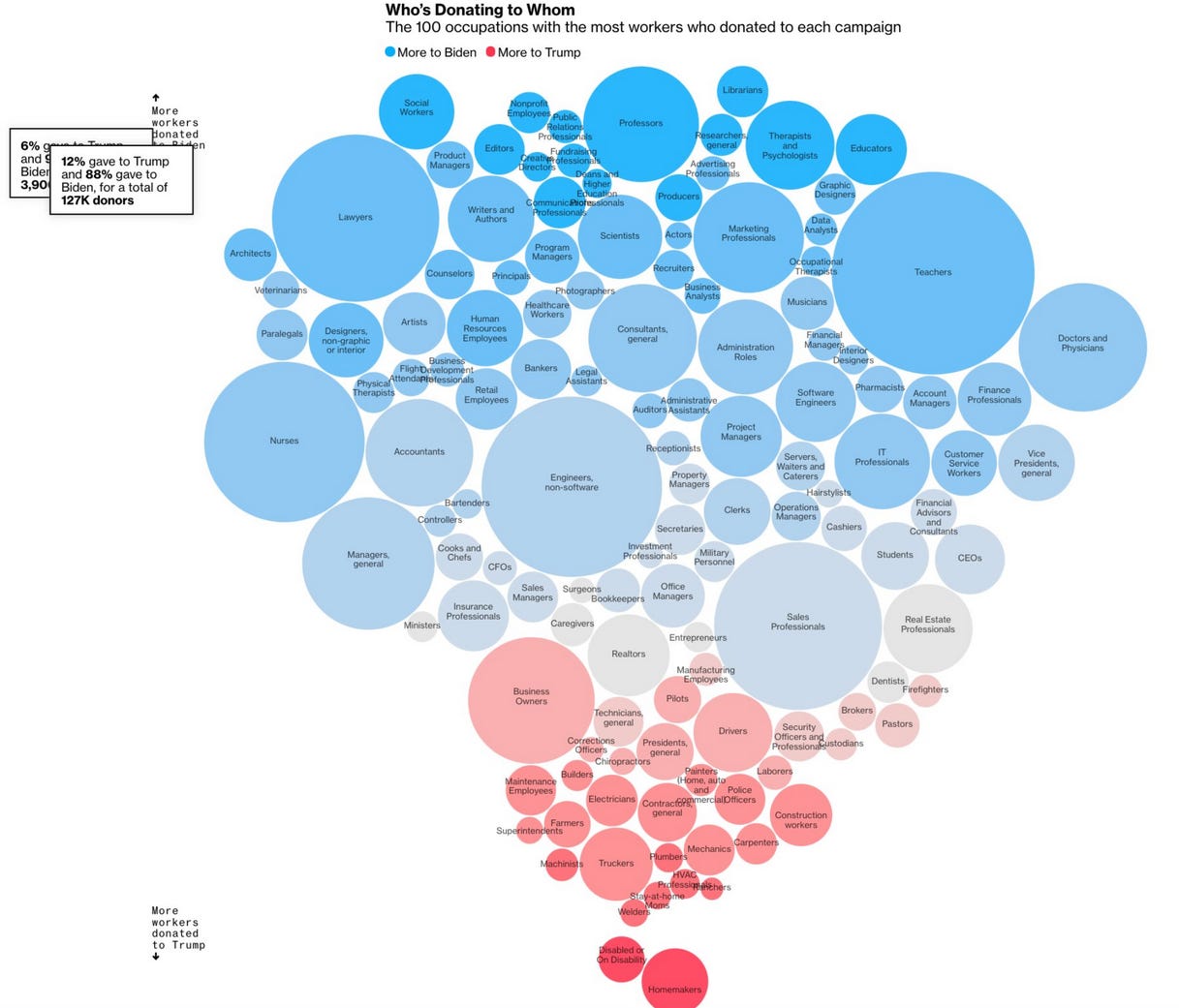 Hanania uses this graphic to show that Democrats donate more than Republicans. But it’s also worth noting that top Democratic donor groups include professors, educators, and nonprofit employees, and top Republican donor groups include (squints really hard) homemakers, welders, and disabled people. Which coalition do you expect to end up with more power?
Hanania uses this graphic to show that Democrats donate more than Republicans. But it’s also worth noting that top Democratic donor groups include professors, educators, and nonprofit employees, and top Republican donor groups include (squints really hard) homemakers, welders, and disabled people. Which coalition do you expect to end up with more power?
In this model, we end up with Woke Capital because Apple and Amazon are run by programmers, by managers who used to be programmers, and by MBA finance people - and all of those groups are highly educated and therefore liberal. In the past it might have also mattered that Apple and Amazon are run by rich people, but in the US that’s stopped predicting anything.
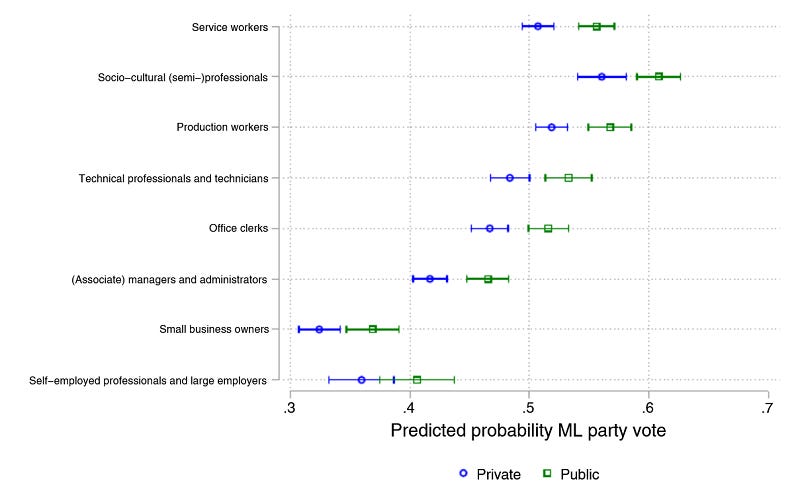 This is from this commentary on Piketty. ML stands for Mainstream Left. All of these are artificially low because they’re from Europe and exclude the non-mainstream left, here used to mean Greens. Ignore the exact numbers and pay attention to the relative propotions, eg for sociocultural professionals.
This is from this commentary on Piketty. ML stands for Mainstream Left. All of these are artificially low because they’re from Europe and exclude the non-mainstream left, here used to mean Greens. Ignore the exact numbers and pay attention to the relative propotions, eg for sociocultural professionals.
So if you rephrase Hanania’s question as “how come the party of highly-educated people has more power over academia, tech, and media than the party of less-educated people?”, it kind of answers itself.
My overall model of this is that the US two party system forces everyone to divide into two coalitions with equal number of voters (slightly modulated by structural issues like the Republican electoral advantage in eg the Senate). For some reason - maybe the one Piketty mentioned - a lot of this sorting is now being done by education. If you have two coalitions with equal numbers of people, but all the educated people on one side, that side is going to control more institutions. Then those institutions will support the interests and values of the people in that coalition (including people in the coalition for reasons other than education) and be against the opposite coalition. This will be a self-perpetuating cycle as those institutions start selecting for people who share their values, both explicitly (“we don’t like this person because they have bad values”) and implicitly (networking, “bad culture fit”, etc). This is partly worsened by, and partly another way of describing, the class gap between educated and uneducated people, where they end up with different aesthetics, dialects, social norms, etc - which transmutes fear of transgressing class norms into fear of having the wrong opinion.
III.
This is a little more pressing than it might otherwise be, because I get the feeling Hanania is using his own explanation (liberals care more) as an apology for dictatorship. After quoting some of my piece on Turkish dictator Recep Erdogan, he writes:
To steelman the populist position, democracy does not reflect the will of the citizenry, it reflects the will of an activist class, which is not representative of the general population. Populists, in order to bring institutions more in line with what the majority of the people want, need to rely on a more centralized and heavy-handed government. The strongman is liberation from elites, who aren’t the best citizens, but those with the most desire to control people’s lives, often to enforce their idiosyncratic belief system on the rest of the public, and also a liberation from having to become like elites in order to fight them, so conservatives don’t have to give up on things like hobbies and starting families and devote their lives to activism.
I’m not suggesting this is the path conservatives should take; they might feel that a stronger, more centralized and powerful government is too contrary to their own ideals. In that case, however, they’ll have to reconcile themselves to continue to lose the culture into the foreseeable future, at least until they are able to inspire a critical mass to do more than just vote its preferences.
I’m against dictatorship, but I agree that Hanania has given a good explanation of why it might feel attractive to conservatives. If my explanation is right and his is wrong, does that defuse the case?
It’s hard to say. We’re both coming from a position of wondering why liberals are dominating institutions more these days. But Piketty’s theory doesn’t naturally explain this. He describes the shift from a 1950s coalition system (educational/financial elites vs. commoners) to a 2020s coalition system (educational elites vs. financial elites with some commoners on both sides - or, in America, educational elites + some financial elites + commoners vs. other financial elites + commoners). Surely the 1950s system should have had the elites dominate institutions even more, given that the financial and educational elites were on the same side and could combine their powers to do this? Conservatives did dominate institutions somewhat in the 1950s, though there were still a lot of socialist professors and newspapers. Maybe there’s a natural tendency for some of these organizations to lean left wing (eg colleges are heavily exposed to the opinions of young people, who lean left), and in the 1950s system this was counterbalancing elite pressure, whereas now it’s exacerbating it? Maybe it’s just that there was less partisanship full stop in the 1950s so this didn’t matter as much? I think you could tell a story where this was true, then we went through a shift in the eg 1980s where educated people weren’t disproportionately on one side or the other, and now that we’ve completed the shift to educated people on the left, in a much higher partisanship environment, it’s hitting us really hard.
If that’s true, then I think this is a slightly rosier and less-dictatorship-suggesting situation than the one Hanania describes. But it still sucks. If one ethnic group is Democrat and another is Republican, this is only bad in the usual ways. But if one education level / professional group is Democrat and another is Republican, you get different ones capturing different institutions and then all the institutions are fighting against each other. Also, institutions lose viewpoint diversity and become monocultures. Also, people become suspicious of institutions that have been captured by people of the other political party and stop trusting them, and then society can’t reach a normal epistemic consensus.
Instead of requiring dictatorship, this just requires…man, I have no idea. Applying some sort of brake (or accelerator) to Piketty’s Ferris wheel? How would you even start doing such a thing?
I think I would go with the same recommendations in my post on Republicans and class - try to decrease the salience of college in society, so that not every smart person needs to get a college degree, and not every important job is degree-gated. Probably solving racism would help shake up political coalitions, so somebody should do that too.
But this raises the question - what coalition system would we rather have? Maybe a genuine multi-elite one with financial elites fighting educational elites would work better? At least financial elites usually have some education, are competent enough to prevent their party from getting too embarrassing, and can exercise some control over institutions. Maybe going back to the all elites vs. all people would work better (even though it seems like it should work worse?) Maybe this is the wrong axis and we need to focus on decreasing partisanship somehow?
Piketty’s paper includes a great 1925 quote by John Maynard Keynes on why he would never vote Labour: “I do not believe that the intellectual elements in the Labour Party will ever exercise adequate control; too much will always be decided by those who do not know at all what they are talking about.” Right now I think a lot of people feel the same way about the Republicans. The Labour Party managed to change its ways - all we can do is hope the Republicans can too.

